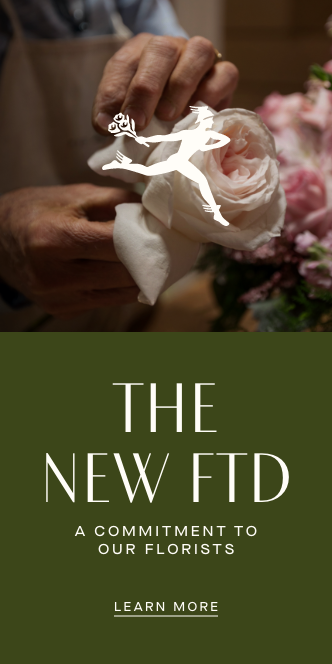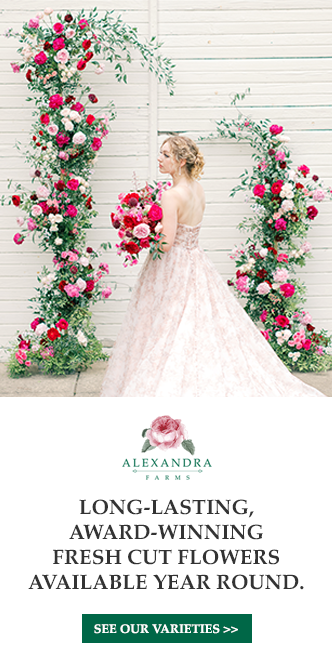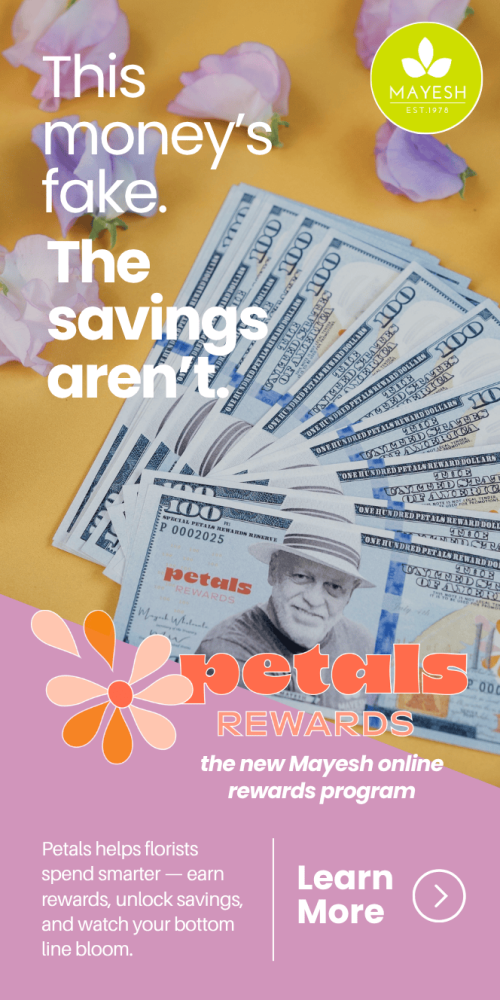
Seed to Sale
The Journey of a Flower
“Big, open, fluffy blooms—with lots of saturated color. Our bride, Meryl, wanted the full effect of old-fashioned romantic garden roses for her wedding day,” shares Holly Heider Chapple of Holly Chapple Flowers. Chapple’s northern-Virginia- based studio specializes in premium flowers for life’s big and everyday events.
The global supply chain is a vibrant patchwork of people, flowers and logistics that assimilates beauty from every part of the world. “I splurge on gorgeous premium blooms because it’s what defines my studio’s brand. And beauty comes from everywhere,” Chapple says. Chapple’s northern-Virginia-based studio specializes in premium flowers for life’s big and everyday events.
“I don’t know much about flowers, so I just told Holly I wanted lush, full flowers—and that I loved garden roses!” 2021 bride Meryl Miner informs. “I wanted to steer away from whites and traditional blush bridal colors, instead preferring variations of reds and corals as a complement to the blue chinoiserie jars we chose.”

In Colombia’s mountain steppe region, the sun rises predictably just before 6 a.m. every day. Maria Salcedo and 350 other Alexandra Farms employees arrive to tend, cut and pack the 300,000 garden roses they ship each week from the farm’s 1 million specialty garden rose bushes.
“We started Alexandra Farms because we wanted to bring back the romance to cut roses,” Joey Azout, president of Alexandra Farms informs. “We asked ourselves, ‘Where are the roses that had fragrance? Where are the roses that would prolifically bloom in the vase and perform for the consumers?” Bred primarily for bud volume and stem length, traditional roses had lost their appeal to Azout.
“We set out to find, grow and sell those poetic garden roses,” Azout continues. “And, at first, it was not easy to find garden rose varieties because breeders were filling growers’ needs for hardy roses that would be productive and survive the trip from Quito to Moscow. But hard work, lots of travel and perseverance allowed us to select beautiful, romantic roses to grow. And after 10 years, we have been able to select and grow more than 60 varieties that have the characteristics we were looking for.”
Alexandra Farms is a niche grower in part of the $34 billion global flower trade. It specializes in a collection of David Austin English garden roses, which have been specifically bred for floristry, as well as garden roses from other prominent breeders. And while the perishable cut-flower clock starts ticking at the snip of the cutting shears, the production process actually begins long before the blades come out.
Plant Breeding: Making the Cut
Around the world, plant breeders specializing in one or several cut- flower varieties are working in labs and greenhouses to design better flowers for florists and their customers.
“It’s a mixture of skill, science and luck,” the late renowned rose breeder David Austin Sr. used to say. Austin led the way in transforming the roses, creating a new breed of rose for the garden and, subsequently, launching an iconic collection of roses for the cut-flower industry, 15 varieties of which are grown at Alexandra Farms.


Crossing parent plants into new offspring can introduce not only new desirable traits in flower color, form and/or stem length but also production variables like disease resistance or lower water or fertilizer needs. But plant breeding is a long game compared to the logistical sprint once a flower is cut. Creating and trailing a successful new flower variety can take up to 10 years!
It’s a cutthroat process designed to advance only the most promising plants. Breeders of familiar flowers, like Gypsophila paniculata (baby’s breath) or Dianthus caryophyllus (carnation), may start with as many as 10,000 new contenders. The competition is fierce through three rounds of increasingly scrutinized selection. It’s an ongoing process of crossing and regrowing the promising contenders. The best must ultimately square off with commercially available varieties for a final attempt to outperform and win approval. Only a handful of the contenders make it through the selection process. But building a better bloom doesn’t end within the breeder’s greenhouse.
The promising new lines are offered to propagation growers (the flower farmers’ sources for plants) to field trial against current market varieties. If one of the up-and-comers can outperform at this level, the breeders are in business. They ramp up seed or plant availability, and a new variety is named.
The improvements sometimes appear subtle but have a significant impact on the supply chain. One improvement in Gypsophila made by Ball SB, a cut-flower hybridizer in Colombia, is plant resiliency. Older plant varieties of Gypsophila often died after cutting a single flush of blooms, resulting in a farm loss of up to 50 percent of the crop.
“Our introductions have reduced losses to 1 percent,” says Manuel Gastelbondo, research and development director at Ball SB. “It’s a huge saving for growers to be able to harvest multiple bloom flushes from the same plant. If you want to see the difference plant breeding has made in flowers, simply look at the wild mother species of any flower. Breeding has increased the size, quantity and colors of flowers in addition to stem length and durability. There’s a lot of science behind it.”

The Roses of Success
Alexandra Farms specializes in artisan-quality garden roses. Selecting varieties from breeders across the world including Holland, Japan and the U.K., the company is the largest licensed grower of David Austin Roses. But the field is always changing.
As part of its floristry rose breeding program, David Austin Roses crosses more than 20,000 roses each year, all done by hand. The promising crosses are grown out and evaluated over a five-year period, at which point another cull is made. From the initial lot, only nine or 10 “child” plants are chosen to propagate in greater quantity for further assessment, and only one or two of the original 20,000 possibilities will be selected for introduction.

The goal remains the same: to try to develop the healthiest roses possible without compromising their beauty; fragrance; grace; and, most important, their charm.” This vision remains true today, led with equal passion by his eldest son, David Austin Jr.”
-David Austin Sr.
Staying On-trend in the Field
The decade-long selection process makes it challenging for breeders and growers to align with shape-shifting color and design trends. “Trends move fast in this industry,” Gastelbondo notes. “We maintain strong relationships with marketing and our growers, to understand where the industry is headed. We used to discard promising plant crosses that weren’t on-trend for color or form. But now we keep them. If a cross shows good possibility but isn’t currently in favor, we hold it for future use. You never know when a color will suddenly be back in fashion.”
“It’s tough to predict demand,” Azout confirms. “It takes nine months for a new rose bush to establish before it begins producing, and then the plant can produce roses for another 10 years. But will the color be popular in 10 years? We completely missed the ‘muddy’ rose color trend a while back and then had to rush to catch up. We now have a half dozen skin and sand hues in our collection. I hope it is not just a short-lived trend! It’s about having the right product on the right day.”
The Right Conditions All Year
In Colombia, the right day is every day. The consistent, balanced 12-hour days and ideal soil and temperatures make the country the second-largest floral exporter in the world (behind the Netherlands) and the U.S.’s No. 1 source for imported cut flowers.
But Colombia’s year-round growing conditions make for year-round marketing challenges. The U.S. may be the largest global importer of flowers (an estimated 80 percent of the cut flowers sold in the U.S. are imported), but U.S. consumers spend relatively little on cut flowers, at $35/person/ year compared to $135/person/year by Japanese consumers. Most U.S. spending is pulsed on holiday or event purchases rather than everyday flowers. So year-round producers, like those in temperate regions, must find other markets for the flowers during the U.S.’s off-seasons.
“Our plants produce constantly,” Azout explains. “Importers help us sell what we have coming available in production, but we have to find year-round markets to keep our employees busy and our plants tended. During North America’s winter, we often ship to countries in the Southern Hemisphere and Russia, which consume flowers year-round.” Azout also markets his garden roses as substitutes for peonies, which aren’t available 12 months a year.




Supply-chain Continuity Starts with Diversity
While imported flowers dominate the U.S. market, there is a strong and growing contingent of U.S. cut-flower growers. CalFlowers, The California Association of Flower Growers & Shippers, is an industry trade association committed to help U.S. cut-flower growers efficiently distribute their product. The group originated with California growers but now offers membership nationwide.
“Transportation is the largest single cost in the floral supply chain,” reports Steve Dionne, executive director of CalFlowers. “Our goal is to keep transport costs low and let designers know that having the best doesn’t have to mean the most expensive. CalFlowers relationship with FedEx gives growers affordable access to express shipping, albeit unrefrigerated transport.
“Peonies are a good case study on production,” Dionne continues. “When they bloom, it’s fast and hard. Most varieties are done in two weeks. While stems can be held in cold storage at length, a diversity of supply origin ensures availability over a longer period.”
“Some florists and consumers are very origin focused, and there’s definitely a business for that,” Dionne elaborates. “Many florists, however, are interested in the greatest diversity and best-quality product for their customers. This past year has proved that retailers need multiple relationships across the supply chain. It’s about finding a smart supply chain comprising domestic flower farms, importers and wholesalers. We need diversity in supply.”
Sourcing has been an acute challenge during the COVID-19 pandemic. “I hear a lot of florists saying there are no flowers available right now, but that’s largely because they are all asking for the same things!” Chapple observes. “There is a whole pool of flowers available from local growers that add a unique beauty that some florists just aren’t thinking about.”
The Shears Start the Clock Ticking
Growing cut flowers in ideal climates for year-long production results in a geographically disperse industry. And moving this delicate cornucopia requires a logistical marvel. Although cut-flower varieties are meticulously bred and selected for longevity, they are living products about to be severed from their life sources.
Back at Alexandra Farms, Salcedo surveys her jurisdiction of ‘Red Piano’, ‘Romantic Antike’, and ‘Wanted’ garden roses. She’s been through the rows with her shears once this particular morning but is back for a second of three cuts today. Several of these boxes will be bound for a D.C. wholesaler and, ultimately, Chapple’s studio, for Meryl Miner’s upcoming wedding.
“Our garden roses must be cut at an exact moment in their development for peak quality,” Azout points out. “We cut three times a day. Flowers are graded for color, uniformity and stem length before being individually wrapped and bunched.
Graded flowers spend up to eight hours in cold hydration after being meticulously wrapped in bunches, with cards identifying their diligent handlers. The bunches are then boxed with labels identifying the customers. The sealed boxes are held in refrigeration until they leave for Bogotá’s El Dorado International Airport. The perishable clock is ticking, but slowly.
Cold Chain
Flowers rely on their parent plants to photosynthesize food and provide life-giving water to the blooms. Once the cut is made, a flower must be hydrated quickly and then survive on foliage-stored food until supplemented again. Azout’s garden roses, like many flowers, are shipped dry but cold. Maintaining the cold chain is the industry’s keystone to flower freshness.


At 33 F to 35 F, a flower’s metabolism slows to a crawl. The chilly (but not freezing) temperatures induce a hibernation-like state that slows the rate of food consumption and aging of the flowers. Violating the industry’s cold-chain protocol can be costly and, occasionally, uncontrollable. Unfavorable weather conditions, flight delays, loading docks and airport tarmacs are all opportunities for temperature lapses. “Above 38 F, the rate of decline accelerates rapidly,” Azout assures.
But the cut-flower industry is finely tuned to perform cool, swift handoffs. Refrigerated trucks deliver Alexandra Farms’ flower boxes to Bogotá’s airport, bound for Miami International Airport. Colombia alone sends 17 planeloads of cut flowers into Miami every day, six days a week. Most arrive on dedicated cargo planes, but many, especially from other parts of the world, travel in the underbelly of passenger flights.
A Sudden Stop
Azout’s roses, along with the other 40,000 boxes of cut flowers imported to the U.S. each day, make one requisite refrigerated stop: a visit with U.S. Customs and Border Protection officials. For 90 percent of U.S. cut- flower imports, that’s in Miami, where agricultural specialists inspect billions of blooms annually (1 billion from Colombia alone) looking for insects and diseases that could spread to American crops. While only a small number of pests are discovered each year, the threat is real and potentially significant. No stone goes unturned.

Peak import times ahead of Valentine’s Day and Mother’s Day, or other logistical troubles, can delay inspection. While shipments await their turn in gigantic basketball-court- size coolers, the perishability clock is still slowly ticking away.
On the Move Again
Once approved through customs, usually within eight to 12 hours, the boxed floral bottleneck flows rapidly to Miami’s many expectant importers. Many of these conglomerates own and/or partner with international farms to import and distribute to American wholesalers.
“Every step in the distribution process adds value,” says Mario Vicente, general manager of Miami importer Fresca Farms. “Importers are a one- stop-shop, aggregating multitudes of flowers from all over the world and providing important quality control so that customers receive only the finest-quality flowers.” And it happens in a flash. Once flowers are cleared through customs, importers quickly collect their shipments, break down the multi- source boxes and inventory the whole lot—all in refrigerated facilities. Within 24 hours, flowers are shuffled to meet order demand and loaded back on to refrigerated trucks bound for wholesalers across the country.
“If all goes well, an order sold on Monday can be delivered to a wholesaler in New York by Thursday,” Azout reports.
Arranged Delivery
Alexandra Farms’ garden roses are shipped immediately from Miami to wholesalers across the U.S. But some more-common flowers spend an extra day onsite at an importer or bouquet operation, to be recut, arranged and wet packed for supermarkets and other customers.
“Our wet-pack operation serves customers of all sizes—really anyone who wants to save on labor costs and do more volume,” Vicente states.
Ready-made bouquets are popular with grocery stores and even smaller florist shops that want to offer a value- conscious product.
Nationwide, wholesalers receive flower shipments daily. Wholesalers offer local florists and designers access to the global array of imported; domestic; and, sometimes, local blooms—hopefully with financial margin to spare.
“I love working with my wholesale partners,” Chapple emphasizes. “They know the best sources for high-quality blooms. If there is a shortage, they can make substitutions for me. If you purchase directly from a farm and something goes wrong, you’re stuck. This is a relationship business, and we need our wholesalers.”
Aggregating Beauty
Chapple’s studio ramps up when flowers arrive on Tuesdays. Salcedo’s thoughtfully packed roses for Meryl Miner’s wedding have arrived. Once the flowers are unpacked and conditioned, Chapple’s design work begins by creating a sample “recipe” based on her creative vision. If it passes Chapple’s critical eye, full production ensues on Thursday, for a weekend event.
Chapple’s style centers on an old-world aesthetic, which Alexandra Farms’ roses provide. “I am obsessed with garden roses,” she enthuses. “When you pull together the charm of these roses with what we, or others, grow locally, it’s pure magic!”
Bride Meryl Miner says, “Our wedding flowers were absolutely perfect— better than I imagined. The flowers fit seamlessly into the space and brought the room to life by bringing out the rich colors in the space. We also planned the linens, plates and chairs to be simple, specifically to give a beautiful palette for Holly’s arrangements. I truly loved every aspect of the flowers!”
Global Bouquets
As a floral designer and also owner of Hope Flower Farm, in Waterford, Va., Chapple sees both sides of the floral industry. “I’m a designer who farms,” she laughs. “Design comes first in our studio, but we have to understand what’s available seasonally.”
Chapple supplements her locally grown and locally sourced stems with purchased luxury blooms, like garden roses. “Designing with premium blooms just beckons clients,” she offers. “Our farm’s retail focus is on farm-fresh blooms and branches. But by adding premium flowers that we don’t grow, it makes our bouquets stand out. You really can have both!”
About her relationship with Alexandra Farms, Chapple shares, “I’m delighted to have the opportunity to work with Alexandra Farms—because of the flowers and the people. I’ve visited the farm and seen how much Joey cares about his staff. It has created a kinship with me. It makes me proud that my little company can help support people there and have a ripple effect.”
Vases Have Room for All
We adorn our homes and events with lovely blooming things—a simple reflection of our appreciation for natural beauty from every corner of the earth. Each different flower shape and color represents the diversity of faces and places on our planet.
Today’s global economy affords us access to this myriad of plant biology. Some blooms ship well. Some don’t, and those blooms demand local cultivation for the highest quality. Some plants are notoriously picky in their growing conditions, and others are quite adaptable. Each brings a unique beauty and appeal to its admirer.
A floral designer’s palette necessitates an expanding spectrum of lines and pigments to create his or her living canvases. In the melting pots of American bridal bouquets and vases, there is room for all.

Related Articles
Related
The Art (and Algorithm) of Valentine’s Day 2026
How AI, sustainability and emotional design are transforming one of the industry’s biggest days. By Kat Castagnoli, AIFD With Valentine’s Day 2026 landing on a Saturday, florists nationwide are bracing for a complex mix of opportunity and chaos. The good news?...
Guided by Nature
Korean floral design beckons tranquility in a hectic world. By Bianca Bina Spacious, balanced and natural. Grounded in foundational principles, Korean design is built on a simple yet intentional framework that embraces ethereal, asymmetric forms. Every element...
2025 Holiday Trends
Big bows, bold blooms and vintage vibes capture the spotlight. By Kat Castagnoli, AIFD, CCF In a season brimming with velvet ribbons, oversized ornaments and cozy color palettes, this year’s holiday decor trends are all about curated contrast. Think maximalism meets...






















